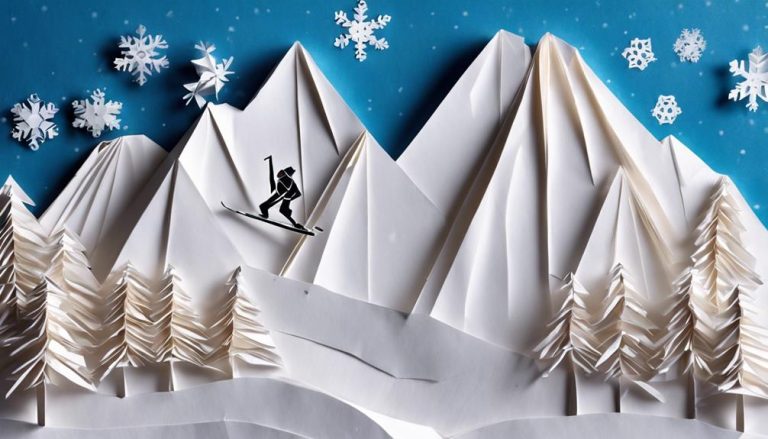General Rules of Snow Golf
When it comes to snow golf, you may not be aware that the rules differ slightly from traditional golf. Understanding the nuances of playing on snow-covered courses can enhance your winter golfing experience. From navigating snowy terrain to adapting your equipment, there are specific guidelines to follow. By familiarizing yourself with these general rules, you can ensure a smooth and enjoyable snow golf game.
Snow Golf Equipment
When gearing up for snow golf, you'll need specialized equipment to tackle the unique challenges of the winter sport. Snow golf apparel and accessories are essential for staying warm and comfortable while navigating the snowy course. Opt for waterproof and insulated clothing to shield yourself from the cold and wet conditions. Layering is key to regulating body temperature as you move through the winter wonderland.
Accessories such as thermal gloves, hand warmers, and winter hats are crucial for maintaining dexterity and focus during your game. Winter golf course management is also vital in snow golf. Courses need to be carefully maintained to ensure safe and enjoyable gameplay. Clearing snow from the greens, tees, and fairways is necessary for proper ball movement and player safety.
Having the right equipment and gear for snow golf sets the foundation for a successful and enjoyable experience on the winter course. Embrace the challenges and thrills of this unique sport with the proper attire and accessories.
Teeing Off in Snow
When teeing off in snow, it's crucial to consider the proper tee height, ball placement technique, and adjusting your swing power. By setting the tee at the right height, you ensure a clean strike on the ball despite the snowy terrain. Correct ball placement and adapting your swing power are key elements to mastering the art of teeing off in the snow.
Proper Tee Height
Using the right tee height when teeing off in the snow can significantly impact your game and overall experience on the snow-covered golf course. Proper tee height is crucial in snow golf due to varying snow consistency and conditions. Adjusting the tee height according to the snow conditions is essential to ensure a successful shot. When the snow is fluffy, a higher tee height is recommended to prevent the ball from getting buried upon impact. On the other hand, if the snow is compact, a lower tee height can provide better stability for your ball. Finding the right balance in tee height adjustment based on the snow conditions will help you achieve more accurate and satisfying shots while playing snow golf.
Ball Placement Technique
To improve your ball placement technique when teeing off in the snow, consider the impact of snow consistency on your shot accuracy and adjust accordingly for optimal performance. When setting up for your shot, ensure proper ball alignment with your target and apply your normal putting technique. In snowy conditions, it's vital to adapt your club selection based on the distance and the density of the snow. If your ball lands in a snow bunker, strategize your shot by considering the depth of the snow and the lie of your ball. By adjusting your approach to match the snow conditions, you'll have a better chance of hitting accurate shots and enjoying a successful round of snow golf.
Adjusting Swing Power
Adjust your swing power when teeing off in the snow by gauging the resistance the snow provides and making necessary adjustments for a controlled and accurate shot. The key to a successful shot lies in mastering the art of power control and precision. Here's how to enhance your snow golf experience:
- Feel the Resistance: Sense the snow's resistance as you swing, adjusting your power accordingly.
- Focus on Consistency: Maintain a consistent swing tempo to counter the snow's impact on the ball's flight path.
- Visualize Your Shot: Envision the trajectory you want the ball to take, allowing you to fine-tune your swing for maximum accuracy.
Ball Marking Rules
When marking your ball in snow golf, remember to choose a distinct color for easy spotting. Use marking tools like coins or special golf markers to mark your ball's position accurately. Ensure you remove your mark once your ball is played to avoid confusion for other players.
Ball Color Selection
Selecting the color of your golf ball is a crucial step in adhering to the ball marking rules of snow golf. When choosing the right color, consider these key points:
- Ball visibility: Opt for vibrant hues like neon yellow or bright orange to ensure your ball stands out against the snowy backdrop.
- Camouflage: Avoid white or light-colored balls that can easily blend in with the snow, making them difficult to spot.
- Weather impact: Darker colored balls like red or blue are easier to locate if the weather turns overcast or snowfall intensifies.
Make sure your ball color contrasts with the snow to maintain visibility and enhance your snow golfing experience.
Marking Tools Allowed
To effectively mark your golf ball in snow golf, permissible tools for marking include items such as colored stickers, sharpies, or specialized stamps designed for use on golf balls. When choosing your marking tools, consider the marker options that work best in various snow conditions. For optimal visibility in the white landscape of snow golf, vibrant colors like neon pink or bright orange are recommended. These tools not only help you easily identify your ball but also add a fun and personalized touch to your game. Ensuring your mark stands out against the snow will prevent any visibility concerns during the game, making it easier for you and other players to track the ball's movement on the course.
| Marker Options | Snow Conditions | Visibility Concerns | Snow Golf |
|---|---|---|---|
| Colored Stickers | Fresh Snow | Neon Colors | Fun Game |
| Sharpies | Packed Snow | Bright Shades | Personalized |
| Specialized Stamps | Melting Snow | High-Contrast | Easy Tracking |
Clear Mark Removal
After marking your golf ball with the approved tools for snow golf, ensuring clear mark removal is essential to maintain fair play and avoid any confusion during the game. In snow golf, visibility is crucial, so here are some techniques to remove marks effectively:
- Gently Pat the Snow: Use your glove or a soft cloth to pat down the snow around the mark, smoothing it out to blend with the surroundings.
- Use the Edge of a Club: Carefully scrape the surface of the snow around the mark with the edge of your club to level it with the rest of the area.
- Blow or Brush Away Excess Snow: Lightly blow on the mark or use a brush to remove any remaining snow particles, ensuring a clear and clean surface for your next shot.
Snowy Terrain Etiquette
Wondering how to navigate the snowy terrain with grace and respect while playing snow golf? When engaging in this winter sport, it's crucial to be mindful of the beautiful white landscape and practice good snowy terrain etiquette. While snowball fights and snowman building can be tempting, it's important to remember that the snowy terrain serves as the backdrop for your game.
As you traverse the snow-covered course, be mindful of other players and any snow sculptures they may have created. Avoid disrupting these creations and maintain a sense of respect for the winter wonderland around you. Additionally, refrain from engaging in snowball fights during your game, as this can be distracting and potentially cause harm to others on the course.
Scoring in Snow Golf
Navigating the snowy course and keeping track of your score in snow golf can be both challenging and rewarding. As you venture through the picturesque winter landscape, it's essential to strategize your gameplay and scoring techniques to stay competitive. Here are some tips to ace your scoring in snow golf:
- Snow Golf Hazards: The white expanse may conceal hazards like icy patches or buried obstacles. Stay vigilant and adapt your shots to avoid these challenges for a smoother gameplay experience.
- Scoring Strategies: To maintain a competitive edge, focus on consistency and accuracy in your shots. Adjust your swing to accommodate the snowy terrain and aim for precision to score well against your competitors.
- Staying Competitive: Keep a close eye on your opponents' scores and adjust your gameplay accordingly. Embrace the friendly competition and let the thrill of the game drive you to improve your scoring techniques in the enchanting snow-covered course.
Winter Golf Safety Tips
For a safe and enjoyable winter golfing experience, it's crucial to be mindful of specific safety tips to navigate the snowy course with confidence. When gearing up for a round of snow golf, layering clothing is key. Start with a moisture-wicking base layer to keep sweat away from your skin, add insulating layers like fleece or down, and top it off with a waterproof and windproof outer layer to stay warm and dry. Properly layering your clothing will help regulate your body temperature and keep you comfortable throughout your game.
In addition to layering clothing, it's essential to prioritize frostbite prevention. To avoid frostbite, make sure to cover all exposed skin, especially extremities like fingers, toes, ears, and nose. Consider using hand warmers or heated gloves to keep your hands warm and maintain dexterity. Stay vigilant for any signs of frostbite such as numbness, tingling, or skin discoloration, and seek warmth immediately if you suspect frostbite may be setting in. By following these winter golf safety tips, you can enjoy your snowy golfing adventure while staying safe and comfortable.
Snow Golf Etiquette
As you gear up for your round of snow golf, understanding the etiquette specific to playing in snowy conditions can enhance your overall experience on the course.
When it comes to snow golf etiquette, keep these key points in mind:
- Respect the Snow: Just as you would repair divots on a regular golf course, in snow golf, try to smooth out any large footprints or disturbances you create. This ensures a fair game for everyone following you.
- Mind Your Noise Level: Snow has a unique way of carrying sound, so be mindful of how loud you are talking or celebrating. Keeping noise levels down helps maintain the peaceful ambiance of the snowy course.
- Stay Patient: Snow golf can present challenges that traditional golf does not, such as balls getting lost in deep snow. Exercise patience with yourself and others as you navigate the course with a mix of fun and strategy.
Out of Bounds Protocol
When encountering out of bounds situations in snow golf, promptly identify the nearest designated drop zone for your ball. Weather conditions can greatly impact the boundaries of a snow golf course, making it crucial for players to be aware of their surroundings. In snow golf, player responsibilities extend to respecting course boundaries, especially when dealing with out of bounds areas.
Safety precautions should always be a top priority when navigating out of bounds scenarios. It's essential to assess the situation carefully to avoid any potential risks, such as steep cliffs or icy patches. Being mindful of these hazards will help you make informed decisions to keep yourself and others safe on the course.
Course boundaries in snow golf can sometimes be challenging to distinguish due to the white landscape. Players must familiarize themselves with the course layout beforehand to prevent unintentional out of bounds plays. By staying vigilant and following the designated drop zones, you can navigate out of bounds situations effectively while enjoying a safe and thrilling snow golf experience.
Winter Golf Course Maintenance
Maintaining winter golf courses involves diligent grooming and care to ensure optimal playing conditions for snow golf enthusiasts. When it comes to winter golf course maintenance, there are crucial factors to consider:
- Snow Grooming Techniques: Utilizing specialized equipment like snow groomers, courses are meticulously groomed to create smooth and even playing surfaces. This process not only enhances the aesthetic appeal of the course but also improves playability, making it more enjoyable for golfers.
- Snow Golf Course Design: Designing a snow golf course requires strategic planning to incorporate natural elements like trees and hills while ensuring that the layout is challenging yet accessible. The design of the course plays a significant role in enhancing the overall snow golfing experience, offering a blend of excitement and skill-testing opportunities.
- Environmental Considerations: Winter golf course maintenance also involves environmentally conscious practices to preserve the natural surroundings. From using eco-friendly deicing agents to minimizing disturbances to local wildlife, these considerations ensure that the course remains sustainable and harmonious with its ecosystem.
Frequently Asked Questions
Are There Any Specific Rules or Guidelines for Playing Snow Golf in Extreme Weather Conditions Such as Heavy Snowfall or Blizzards?
When playing snow golf in extreme weather conditions like heavy snowfall or blizzards, it's crucial to prioritize safety. Dress warmly in winter golf attire, follow snow golf etiquette, and strategize for the weather. Stay safe out there!
How Does the Type of Snow (Powdery, Icy, Slushy, Etc.) Affect the Gameplay and Rules of Snow Golf?
Navigating through powdery, icy, or slushy snow impacts your snow golf adventure. Different snow types alter the game's pace, shot accuracy, and strategy. Temperature, snow density, and visibility challenges all add thrilling twists to your gameplay.
Can Players Use Colored Golf Balls or Markers to Make Them More Visible in the Snow?
Yes, you can use colored golf balls or markers as visibility aids in the snow. Bright hues like orange or pink can help you spot your ball easily against the white backdrop, making your game more enjoyable.
Are There Any Special Considerations for Playing Snow Golf at Night or in Low Visibility Conditions?
When playing night golf in the snow, visibility challenges can be tricky. To help, use glow-in-the-dark golf balls or attach light-up markers to your clubs. Ensure you have a reliable light source and stay safe!
What Are Some Tips for Dealing With Obstacles Like Snow Drifts or Uneven Terrain on the Winter Golf Course?
When facing snowy challenges on the winter golf course, remember: "Where there's a will, there's a way." To tackle obstacles like snow drifts or uneven terrain, stay flexible, adapt your swing, and embrace the adventure.






